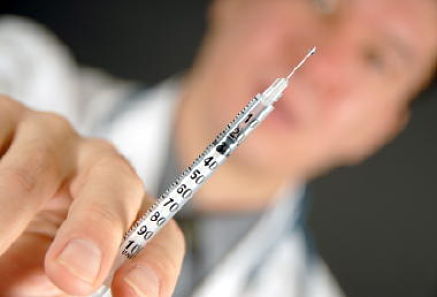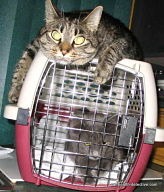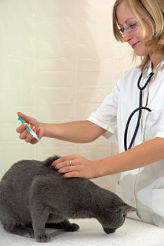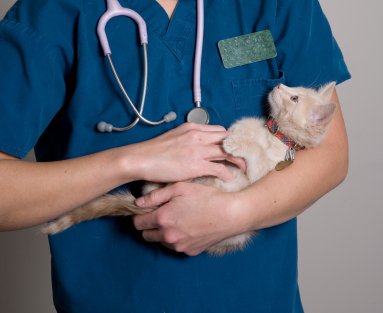Vaccination Site Tumors

Vaccination site tumors...vaccinations save the lives of countless cats each year. But while vaccinations will continue to be life savers, owners need to keep in mind that vaccines are not a panacea. And, as with human vaccines, feline vaccines carry some small degree of risk.
Be selective choosing the cat vaccines that are really necessary, research the effectiveness prior to a feline vaccine. The rabies and FeLV (feline leukemia virus) killed vaccines have been investigated.
Back in 1991, two veterinary pathologists...Drs Mattie Hendrick and Michael Goldschmidt...at the School of Veterinary Medicine at the University of Pennsylvania reported on an increase in certain soft-tissue tumors (fibrosarcomas) at the most common injection sites for feline vaccines.
The increase followed on the heels of a mandatory rabies vaccination program in Pennsylvania. Later investigations studied cats diagnosed with fibrosarcomas. The results of the studies confirmed that there is, indeed, a connection between the increase of vaccination site tumors and the rabies and FeLV vaccines.
Non vaccine-related fibrosarcomas can occur in cats of any age, but older cats are the more likely victims. The standard treatment in such cases is to attempt to surgically remove the tumor and a surrounding area of normal tissue...to make sure no cancer cells remain.
But this surgical approach is usually unsuccessful in the younger, healthier cats with vaccination site tumors due to the typical site of these tumors...between the shoulder blades.
When a tumor is against a bone, it's very difficult to surgically remove the whole tumor because you can't get a big enough margin around it. And if you leave even a single cancerous cell behind, the tumor will recur. Unfortunately, fibrosarcomas are notorious for recurring.
Investigators don't yet fully understand why some vaccines may cause vaccination site tumors in a small number of cats. Nor have investigators found a particular manufacturer's vaccine to be at fault.
Since relatively few cats are stricken, owners should continue to have their cats vaccinated ...with this proviso: find out what vaccines your cat really needs. The combined FVRCP vaccine, which protects cats against feline panleukopania, feline rhinotracheitis, and feline calicivirus, is both safe and effective.
All cats should get it...along with routine boosters. In most states, a rabies vaccination is mandatory. Whenever possible, request a 3 year rather than a 1 year rabies vaccine to lessen the chances of vaccination site tumors.
Unlike the rabies vaccine, the FeLV is a vaccine of choice. It is unnecessary if your cat is 100 percent indoors. Even if an indoor cat darts out momentarily, its chances of catching FeLV are low. An indoor/outdoor cat, on the other hand, is at greater risk and probably should be vaccinated.
Precautions to Take
Recognizing the concern of both veterinarians and cat owners, by November, 1996, the Vaccine Associated Feline Sarcoma Task Force was formed. The following are the recommendations made during those early investigations and subsequent ones.
- Decide which vaccinations the cat really needs and avoid unnecessary ones.
- Don't give killed vaccines between the shoulder blades.
- Standardize vaccination sites. Give the killed rabies vaccine in the upper-rear right leg, the killed FeLV vaccine in the upper rear left leg. Give the modified-live-virus FVRCP vaccine in the right shoulder area. (But never give a modified-live-virus vaccine to a pregnant cat).
- When giving killed vaccines such as the rabies and the FeLV vaccines, make sure only those vaccines that come packaged in single-dose vials are used. When the vaccine comes in multiple-dose-vials, there's a risk that the heavier adjuvants (proteins added to killed vaccines to stimulate the action of the vaccine) will concentrate at the bottom of the dose. Because adjuvants may or may not play a role in tumor development, it's best, to err on the side of caution.
- Make sure there is a notation in your cat's medical records of the location of each vaccination site, the type and serial number of each vaccine, and the manufacturer's name.
- After your cat receives a vaccination, run your fingers over the vaccination site. If you feel a small lump, don't be alarmed...the vaccine is just doing its job. But if the lump grows bigger or persists beyond 3 months, have your cat checked out.
- Should your cat react adversely to any kind of vaccine, encourage your vet to get a report to the vaccine manufacturer and the Veterinary Practitioners' Reporting Program of the United States Pharmacopeia...a program that detects and reports on veterinary product problems.
Related Articles......
Return from Vaccination Site Tumors to Cat Health Homepage
Having trouble finding what you need? Cat Health Index & Site Map
OR
Do you have a question to ask?...Questions
OR
Do you have a cat story to share?...Simply click here to go to that page!
Copyright@2010-2020 All rights reserved.Cat-health-detective.com
This website is information only. Consult a veterinarian for medical assistance

"Like Us" on Facebook
or...
"Like Us" here




















